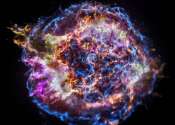Researchers propose new formation model for massive hot subdwarfs
In a new study published in the The Astrophysical Journal, Dr. Li Zhenwei and his collaborators from Yunnan Observatories of the Chinese Academy of Sciences (CAS), and Dr. Zhang Yangyang from the Zhoukou Normal University, ...









